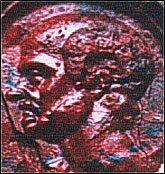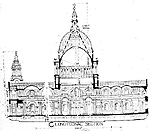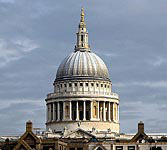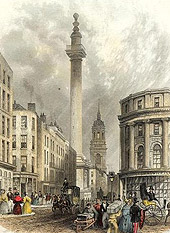 | Robert Hooke, Hooke's Law & the Watch Spring | ||||||||
by Shusaku Horibe
Between 1658 and 1678 Robert Hooke worked on his invention of the watch-spring and developed his theory of elasticity, now known as Hooke's law. The case raises questions about the nature of discovery, credit and priority, and the contributions of 'doers' versus 'thinkers' (work versus ideas).Introduction
This narrative focuses on Hooke's claim to have invented the first portable watch accurate enough to determine longitude in sea navigation — and the drama associated with it. A dispute arose between Hooke and Dutch mathematician-natural philosopher Christiaan Huygens regarding who first originated the idea of using a balance-spring (a coiled strip of metal that acts as a spring) to maintain accurate time in the presence of some external disturbances such as shakes and jerks. From our perspective, the relevance of Hooke's Law (concisely expressed as F = –kx) to the problem of regulating time might be obvious. An ideal spring attached to a weight results in a simple harmonic motion whose natural frequency is resistant to disturbances. The relationship between Hooke's law and its relation to the invention of his watch, however, is not as straightforward as our present understanding of Hooke's law might lead us to believe. First, historical evidence indicates that Hooke probably did not connect the isochronous property of spring oscillation to the invention of his spring-based watch (Hesse, 1966). Second, his insistent claim to priority and his struggle for recognition were filled with drama and reflect the social organization of scientific practice in mid-17th century England, the economics and politics of the time, and the deeply human aspect of scientific endeavor (Jardine 1999; Jardine 2004). Hooke's Diverse Talent
 Meanwhile, in November 1662, Hooke earned a position as curator of experiments at the Royal Society. His job was to prepare and conduct experiments that members of the Society wished performed. This job and his subsequent election as full Fellow of the Royal Society in June 1663 brought him close to real power and influence. Without someone like Hooke who was so talented in building and conducting experiments, the scientific practice of the Royal Society would have faltered.
‘Doers' and ‘Thinkers': A Social Hierarchy Today, Hooke's many contributions have faded from the general public consciousness (Jardine 2004, pp. 1-3). We may regard Newton, Boyle, and Huygens as geniuses of the time, but not Hooke. Although his name shows up in variety of places, apart from Hooke's law of elasticity, no other discovery or inventions are attributed to his name. One might imagine that he just wasn't as smart, creative or original as the others. While Hooke was perhaps not as gifted as others mathematically, elements of social status and hierarchy likely worked against him.
For instance, we do not have any surviving portrait of Hooke. We know of only one that was commissioned by the Royal Society (now missing, possibly destroyed). On top of being a prominent experimentalist at the Royal Society, Hooke was "a chief surveyor for the City of London, and held in great esteem by the Corporation and by leading figures in the East India Company.
My son just made me laugh about the superscription of the letter of Mr. De Louvois, where it has ‘to Mr. Huygens etc., mathematician'. He seems to take him for one of the engineers of his fortifications. I did not know I had craftsmen among my children (quoted by Dijksterhuis 2007, p. 59). Christiaan Huygens was not a mere mathematician; he was above ‘mathematical practitioners', who used mathematics for practical ends. Those who used math for navigation, water management, architecture, etc. -- called ‘mathematiciens' -- were beneath the standing of Huygens, who may be more appropriately called a ‘geometre'. While a clear social distinction existed between ‘higher' and ‘lower' mathematics, Christiaan Huygens' work centered around a practical mechanical device such as a pendulum clock. While he had developed a sophisticated mathematical treatise on the theory of pendulum motion, his ‘high' mathematical work cannot be easily separated from the goal of developing an accurate pendulum clock, which reflected a ‘lower' use of mathematics. Given Huygens' focus on instruments, it is understandable that Le Tellier may have mistaken Christiaan Huygens for a mere ‘mathematician' (Dijksterhuis 2007, pp. 59-61). The role social hierarchy may have played in enabling or constraining the activities of the 17th-century scientists is certainly not absolute, for it was not the case that instrument makers and experimenters were not allowed to participate in the more theoretical side of science. Hooke, for instance, apparently posed a threat to Newton in disagreeing with his theory of light and colors. Wary of criticism, Newton delayed the final publication of the Opticks, his full treatise on the nature of light, until after Hooke's death.
DISCUSSION: What reputations do we assign today to science versus technology, and to scientists versus engineers? How do these reflect our values? In what ways might these values be justified, in what ways not? The Development of the Watch-spring
His instrument designs were not an idle hobby, however, based on mere personal curiosity. They were connected to the contemporary economic concerns. The determination of longitude was a major problem by the mid-17th century. Effective navigation (being able to follow lucrative trade routes or avoid dangerous waters) depended on the precise determination of longitude. The principle of measuring longitude was well understood. The problem was how to do it reliably in practice. One needed a clock able to keep accurate time on long voyages at sea. In the early 1600s, people reset clocks everyday at noon to the position of the sun. Accuracy extended to the nearest fifteen minutes. The development of portable and jerk-resistant watches that could be taken on ships and could keep accurate time for extended periods was an obvious economic concern.
DISCUSSION: What factors seemed to contribute to the discovery of a new clock? What relative significance can be given to personal, economic and social factors?Pendulums versus Balance-springs Right after Huygens got his patent in 1665, Hooke took exception to the supposed novelty. He pointed out the flaws in Huygens' invention. He complained that Huygens was making too big a deal of his invention. Hooke suggested that he had an idea for a better alternative timekeeper, which he had kept secret. Hooke pointed out that the determination of longitude based on pendulum clock could not be guaranteed because all kinds of motion on a ship alter the oscillation of pendulum. Hooke went on to scorn Huygens' claim for his apparent ‘invention: I my self had an other way of continuing and equalling the vibrations of a pendulum by clock work long before I heard of Monsier Zulichems way, nay through equated with a Cycloeid yet I have not either cryd eureka or publisht it and yet I think I can produce a sufficient number of Credible witnesses that can testify for it about these 12 years. Soe that the argument that he soe much Relys upon to secure to him the Invention is not of soe great force as to preswaid all the World that he was the first & sole inventor of that first particular of applying a pendulum to a clock (Jardine 2004, p. 193).
[ Learn how a wind-up watch works.] Hooke wanted in on the patent deal so as to ensure that he got the credit he deserved; he wanted to put his name on his invention before someone else claimed it. For the Royal Society, whose financial situation was worsening, another patent with Hooke's clock was attractive. By summer of 1665, Hooke was negotiating the detail of an appropriate patent. But, the 1665 patent submission never went through because he was asked to concede his rights to any proceeds that were based on future improvements on Hooke's design; why would it be worth applying for a patent if it applied only to the prototype (Jardine 1999, p. 153)?
Disputing Priority In February 1675, Huygens published the details of his balance-spring watch construction in the Journal des Sçavans (the journal of the French academy). He asked Henry Oldenburg, the secretary of the Royal Society to secure a patent for his invention. In March, the Philosophical Transactions, the journal of the Royal Society, published Huygens' watch design and his explanation for it. Hooke learned about the publication and protested vigorously that he deserved the claim to priority since he had presented his invention at the Society's meetings in the early 1660s. In spite of his objections, the Royal Society decided to support the Dutch scientist over their own member.
DISCUSSION: What constitutes a discovery? --Understanding a principle? --Stating or publishing it? --Expressing it mathematically in a formula or equation? --Explaining it? How do we integrate these multiple dimensions of the nature of discovery?  There may well have been a ‘leak' of information between 1665, when Hooke first made public his information, and 1675, when Huygens announced his invention (Jardine 2004, pp. 197-206). Surviving letters show that Henry Oldenburg (right) and Sir Robert Moray (no images available), another prominent member of the Royal Society corresponded with Huygens following Hooke's disclosure of his idea. Even worse, Oldenburg seemed to have "apparently left off the record several occasions on which Hooke had produced balance-spring watches for inspection by the Society" in order to invalidate Hooke's claim to priority. In response, at the end of his 1676 book Helioscopes, Hooke accused Oldenburg of ‘spying' and of endorsing Huygens' claim to have anticipated Hooke's invention.
There may well have been a ‘leak' of information between 1665, when Hooke first made public his information, and 1675, when Huygens announced his invention (Jardine 2004, pp. 197-206). Surviving letters show that Henry Oldenburg (right) and Sir Robert Moray (no images available), another prominent member of the Royal Society corresponded with Huygens following Hooke's disclosure of his idea. Even worse, Oldenburg seemed to have "apparently left off the record several occasions on which Hooke had produced balance-spring watches for inspection by the Society" in order to invalidate Hooke's claim to priority. In response, at the end of his 1676 book Helioscopes, Hooke accused Oldenburg of ‘spying' and of endorsing Huygens' claim to have anticipated Hooke's invention. The incident developed into a huge international priority-dispute. Ultimately, the issue became not who invented it first, now which clock design held more promise for navigational purposes, nor whether they were similar or different, but how to keep the honor of the Royal Society. The Royal Society let Hooke down again in 1676. They formally rebuked Hooke, alleging that he had acted dishonorably to Huygens, and commended "Oldenburg's fidelity and honesty ‘in the management of the intelligence of the Royal Society'" (Jardine 2004, p. 209). Hooke's Law
But Hooke's ‘discovery' contained some confusion and ambiguity. He began his 1678 De potentia restitutiva (Of Spring) by asserting:
The Power of any Spring is in the same proportion with the Tension thereof: That is, if one power stretch or bend it one space, two will bend it two, and three will bend it three, and so forward. Now as the Theory is very short, so the way of trying it is very easie (p. 333). He describes the demonstration of this principle by using not only springs but also (recalling his work with Boyle) a ‘body of air' and a piece of wood. After urging the readers to carefully observe and measure in the introductory section, he finally suggests that
it is very evident that…in every springing body…the force or power thereof to restore it self to its natural position is always proportionate to the Distance or space it is removed therefrom" (p. 336). For us, in retrospect, this is clearly a statement of Hooke's law, but his demonstration of the law and the explanation for it did not match. In order to explain the phenomena, Hooke asks us to imagine a row of eight boxes, each of which contains vibrating microscopic particles. In the unstretched state, the tendency of the vibrating particles to want to recede from each other and the external natural force from the surrounding subtle matter. When the spring is stretched or compressed, the balance is broken and the spring tends to restore its original shape. His model of springs is that of tiny particles vibrating about some central point, and it is the rate of particles' collision with their adjacent neighbors that accounts for the restoring force of springs. Hooke goes on to assert that this mechanical model leads to the statement of the lawlike behavior. But a careful look at his reasoning reveals that his mechanical model does not actually result in a direct proportionality relationship between force and the stretch F = –kx (see Moyer, 1977 for a detailed discussion). Basically, he confuses an inverse square relationship that results from his model for the observed proportional relationship. Even though he demonstrated the law empirically, his theoretical accounts of it were inaccurate. There are a number of interesting (but not always conclusive) interweaving threads here. Hooke goes on to discuss the application of his model from a solid body (spring) to a liquid body like air. Moyer notes that this application yields a correct functional relationship for air (Boyle's law: PV = k). Why did Hooke include discussion of the spring of the air? The fact that Hooke had played a central role in the experimental work with Boyle on ‘the spring of air' must have had some influence on Hooke's thinking. Was his work on the development of watch-spring around the same time mere coincidence? Did his work on watch-spring influence his work on the law of elasticity, or vice versa? If so, in what ways (see figure)? Did he understand, as we do today, that the isochronous property of spring-based vibrations result from Hooke's law? The answer is complex. Although Hooke seems to have known that spring-regulated vibrations can produce isochronous oscillation as a practical matter, ironically, he seems not to have a mature theoretical account of it (Hall, 1951; Hesse, 1966, Moyer 1977).
DISCUSSION: Reconsider your earlier characterizations of discovery and the basis of credit. How does the case of Hooke's law fit or lead you to modify your earlier views?
Recommended Reading For a general biography of Hooke, Jardine (2004) is excellent. On the development of clock technology, see Jardine (1999). Other papers are research articles in the history of science, which are fun to read, but may be quite technical. Robert Hooke website [ www.roberthooke.org.uk ] References
Download PDF || Download Images [2MB ZIP file].
| |||||||||











 He proposed some kind of compact watch regulated by a coiled spring rather than a pendulum and "intended to put his secret concerning the longitude into the hands of the President, to be disposed of as his lordship should think fit" (Jardine 1999, p. 151). No good documentary record of what he actually knew at this point exists (Hall 1951, p. 170). As Hooke later claimed, he apparently had first come up with the idea of using the oscillation of spring for a watch in 1658, but had kept it a secret.
He proposed some kind of compact watch regulated by a coiled spring rather than a pendulum and "intended to put his secret concerning the longitude into the hands of the President, to be disposed of as his lordship should think fit" (Jardine 1999, p. 151). No good documentary record of what he actually knew at this point exists (Hall 1951, p. 170). As Hooke later claimed, he apparently had first come up with the idea of using the oscillation of spring for a watch in 1658, but had kept it a secret. 
